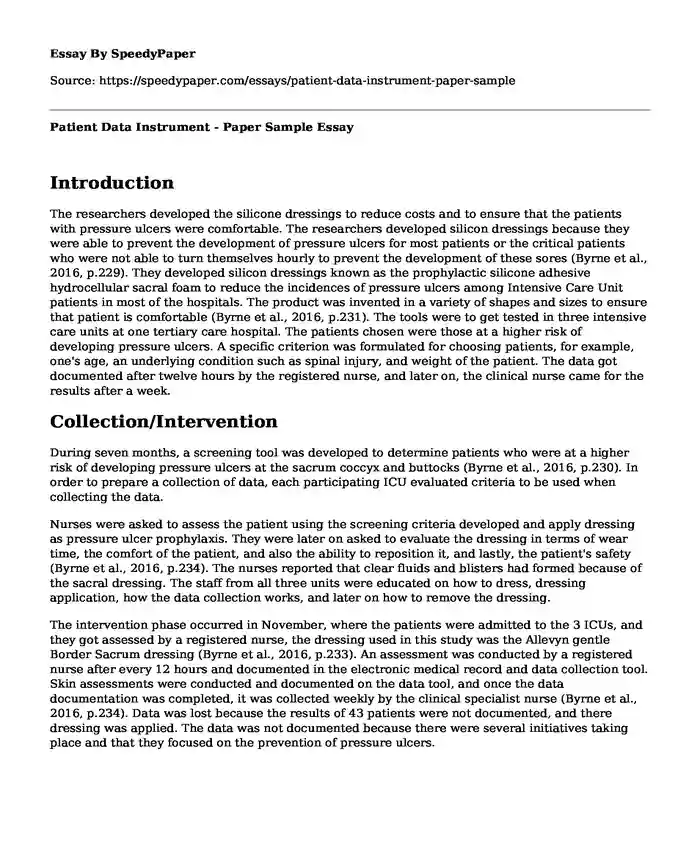
| Type of paper: | Essay |
| Categories: | Health and Social Care Data analysis Nursing care |
| Pages: | 3 |
| Wordcount: | 680 words |
Introduction
The researchers developed the silicone dressings to reduce costs and to ensure that the patients with pressure ulcers were comfortable. The researchers developed silicon dressings because they were able to prevent the development of pressure ulcers for most patients or the critical patients who were not able to turn themselves hourly to prevent the development of these sores (Byrne et al., 2016, p.229). They developed silicon dressings known as the prophylactic silicone adhesive hydrocellular sacral foam to reduce the incidences of pressure ulcers among Intensive Care Unit patients in most of the hospitals. The product was invented in a variety of shapes and sizes to ensure that patient is comfortable (Byrne et al., 2016, p.231). The tools were to get tested in three intensive care units at one tertiary care hospital. The patients chosen were those at a higher risk of developing pressure ulcers. A specific criterion was formulated for choosing patients, for example, one's age, an underlying condition such as spinal injury, and weight of the patient. The data got documented after twelve hours by the registered nurse, and later on, the clinical nurse came for the results after a week.
Collection/Intervention
During seven months, a screening tool was developed to determine patients who were at a higher risk of developing pressure ulcers at the sacrum coccyx and buttocks (Byrne et al., 2016, p.230). In order to prepare a collection of data, each participating ICU evaluated criteria to be used when collecting the data.
Nurses were asked to assess the patient using the screening criteria developed and apply dressing as pressure ulcer prophylaxis. They were later on asked to evaluate the dressing in terms of wear time, the comfort of the patient, and also the ability to reposition it, and lastly, the patient's safety (Byrne et al., 2016, p.234). The nurses reported that clear fluids and blisters had formed because of the sacral dressing. The staff from all three units were educated on how to dress, dressing application, how the data collection works, and later on how to remove the dressing.
The intervention phase occurred in November, where the patients were admitted to the 3 ICUs, and they got assessed by a registered nurse, the dressing used in this study was the Allevyn gentle Border Sacrum dressing (Byrne et al., 2016, p.233). An assessment was conducted by a registered nurse after every 12 hours and documented in the electronic medical record and data collection tool. Skin assessments were conducted and documented on the data tool, and once the data documentation was completed, it was collected weekly by the clinical specialist nurse (Byrne et al., 2016, p.234). Data was lost because the results of 43 patients were not documented, and there dressing was applied. The data was not documented because there were several initiatives taking place and that they focused on the prevention of pressure ulcers.
Analysis
The p-value is used in statistics to determine the significance of one's results in the research (Byrne et al., 2016, p.234). For example, in one's research, the p-value ranged between .08,.031, .021, which indicates that the p-value is less than one; thus, it indicates a null hypothesis.
The limitations of the study included; that the documentation of 43 of the patients was incomplete because the staff was busy preventing any pressure ulcers from developing. Also, not all patients were monitored; thus, the results documented were biased (Byrne et al., 2016, p. 234). The nature of the study did not allow the nurses to record demographic data of their patients, and it denied them to compare data between the total pretrial number of patients and also the population of patients after the trial.
Conclusion
The persons conducting the research introduced bias because there was the development of risk factors that developed from the pressure ulcers but differed completely between two populations (Byrne et al., 2016, p. 234). Also, the research conducted was not randomized.
References
Byrne, J., Nichols, P., Sroczynski, M., Stelmaski, L., Stetzer, M., Line, C., & Carlin, K. (2016). Prophylactic sacral dressing for pressure ulcer prevention in high-risk patients. American Journal of Critical Care, 25(3), 228-234. https://doi.org/10.4037/ajcc2016979
Cite this page
Patient Data Instrument - Paper Sample. (2023, Oct 17). Retrieved from https://speedypaper.com/essays/patient-data-instrument-paper-sample
Request Removal
If you are the original author of this essay and no longer wish to have it published on the SpeedyPaper website, please click below to request its removal:
- Ina's Personal Essay Sample
- Team Development, Free Essay for You
- Essay Example: Big Data and Social Media
- Essay Sample on Correctional Support Services
- Essay Example: Background of Why the Study Was Done
- Essay Example - Misinformation and Disinformation Concerning Coronavirus
- Paper Example on Maternal Smoking during Pregnancy
Popular categories




